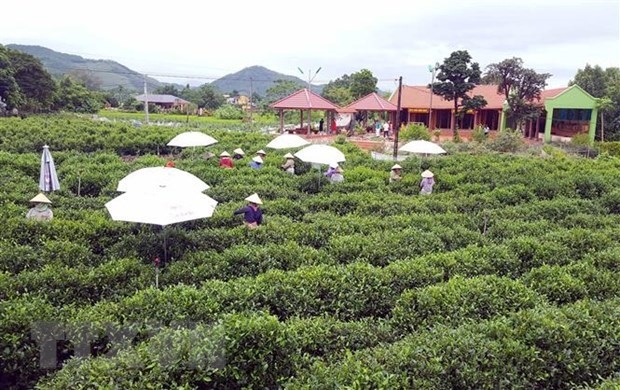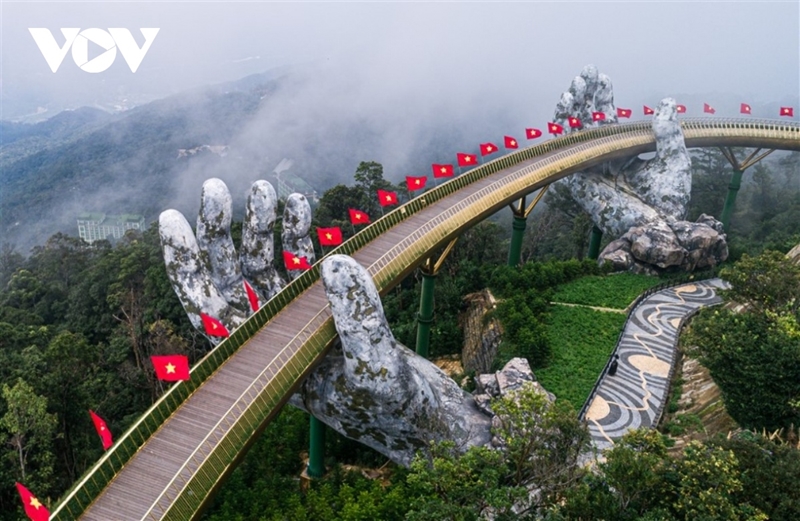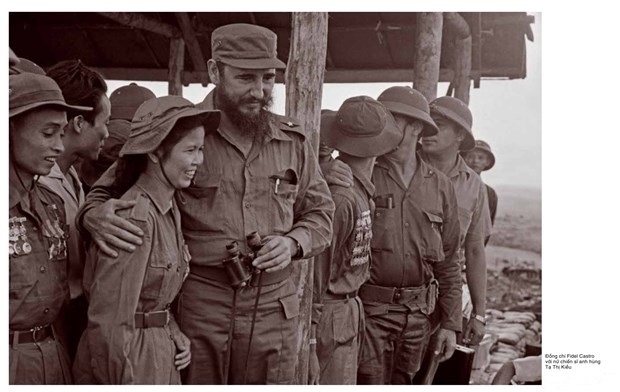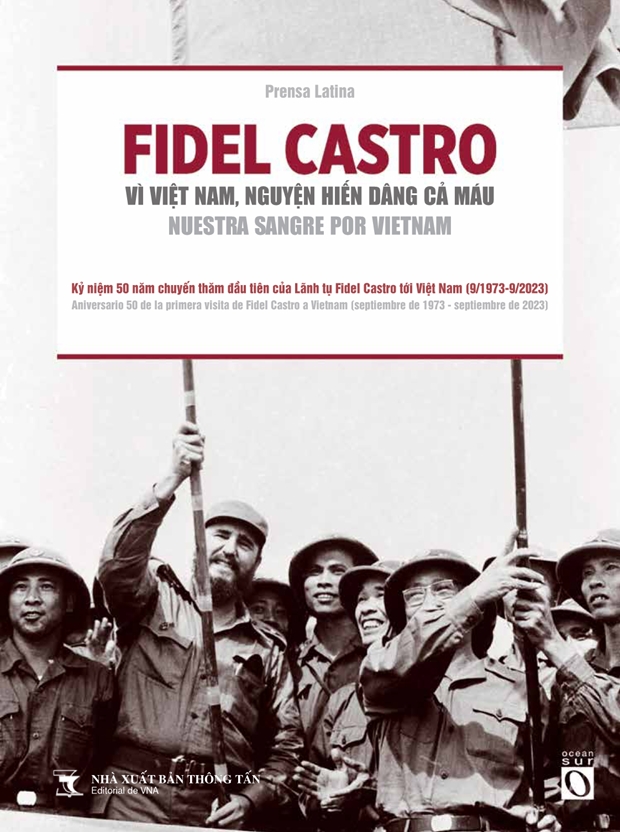 |
| A tea farming zone meeting VietGAP standards in Tan Cuong of Thai Nguyen province (Photo: VNA) |
Tea specialty farming zone becomes magnet for travellers
Tan Cuong is a half-mountain land blessed with favourable climate and soil conditions. Here, local residents have grown tea since the 1920s, forming a panoramic view of endless green hills.
The Tan Cuong tea specialty farming zone covers six communes, namely Tan Cuong, Phuc Xuan, Phuc Triu, Thinh Duc, Quyet Thang, and Phuc Ha, in Thai Nguyen city.
Tan Cuong tea has geographical indication certification that is recognised by the Intellectual Property Office of Vietnam. Meanwhile, the folk knowledge about the Tan Cuong tea cultivation and processing was named in the list of national intangible cultural heritage by the Ministry of Culture, Sports and Tourism.
Aside from making high-quality tea products, locals have moved to develop community tourism linked with their tea culture to meet demand from travellers and also advertise their products.
The Hao Dat Tea Cooperative is an example. It is the first cooperative in Thai Nguyen to have a tea product recognised as a national five-star product under the One Commune, One Product (OCOP) programme.
In recent years, it has created a space of tea culture that features a wooden house for visitors to taste tea and for products to be displayed, along with an area for showcasing traditional tea making methods. This place has welcomed 6,000 Vietnamese and foreign visitors since the start of 2023.
Dao Thanh Hao, Director of the Hao Dat Tea Cooperative, said that making use of existing advantages, her cooperative has launched new services and developed community tourism in its tea farming area. This has helped diversify local tourism products, attract visitors, and directly advertise its produce to consumers.
Others such as the Tien Yen Tea and Community Tourism Cooperative, Tam Tra Thai Cooperative, and Tan Cuong Midland Tea Cooperative are also working to attract tourists. In particular, they have teamed up to establish the Tan Cuong union of community tourism cooperatives.
Last April, the community tourism site of Tan Cuong was recognised by the administration of Thai Nguyen. Setting foot here, visitors can enjoy endless green tea hills, try picking and drying tea buds, learn the folk knowledge about the Tan Cuong tea cultivation and processing, and take a sip of local tea.
Restaurant and accommodation services, along with OCOP products of the province, are also available to travellers.
 |
| Thai Nguyen is developing community-based and agricultural tourism connected with its tea culture. (Illustrative photo: baodautu.vn) |
Developing tea culture-based tourist sites
Apart from Tan Cuong, many other places of community tourism linked with the tea culture are also taking shape in Thai Nguyen such as those in La Bang and Hoang Nong communes of Dai Tu district and Tuc Tranh commune of Phu Luong district.
Duong Van Luong, Secretary of the Party Committee of Thai Nguyen city, said the city will hold more meetings and workshops to give guidance in sustainable and efficient tea cultivation practices to farmers. In particular, it will call on enterprises, cooperatives, and farmers to develop tea cultivation in tandem with community tourism.
In its tourism development plan for 2021-2025 with a vision to 2030, Thai Nguyen province aims to build at least five more community tourism sites based on the tea culture by 2025.
So far, the provincial administration has recognised six community tourism sites, including two tea culture-based ones, which have drawn a large number of visitors. They have helped popularise the Thai Nguyen tea brand and local farm produce while generating higher and more sustainable income for rural residents.
Bored Panda: Golden Bridge is the best known symbol in Vietnam
According to VOV, renowned online magazine Bored Panda recently published an article hailing the charming beauty of Golden Bridge, known as 'Cau Vang' in Vietnamese, in the central coastal city of Da Nang.
 |
| The Cau Vang (Golden Bridge) in the central coastal city of Da Nang |
The magazine described the bridge as so beautiful that it appears as if it has stepped out of a fantasy movie.
“When people first see Golden Bridge, they are always amazed. There is an otherworldly magnificence to the sky-high walkway, which looks like something that might have been dreamed up for a fantasy film,” says Bored Panda.
According to details given by the media outlet, the bridge was first created to construct a ‘pathway’ to connect the Marseille Station to the Garden of Eden and the Le Jardin D’Amour (The Garden of Love) at Sun World Ba Na Hills.
“Set against the lush greenery of nature, and often shrouded in a misty air, when you look at the bridge from a distance it’s as if two giant hands are pulling a golden thread from the mountainside,” it shared.
Bored Panda stressed that it’s no exaggeration to say that the bridge has put Da Nang on the map for hundreds of millions of tourists across Asia and beyond.
“Some might even go as far as saying it’s one of the world’s most iconic man made wonders,” it concluded.
Along with Bored Panda, another popular online magazine UniLad, also likened the bridge to a real-life setting from the blockbuster movie “The Lord of the Rings”. In 2022, this cinematic charm was translated into reality with global audiences watching the Netflix series “The Sandman” and being thrilled to discover a scene that perfectly captured the intricate details of Golden Bridge.
Book on Cuban leader Fidel Castro’s visit to Vietnam introduced
The Vietnam News Agency Publishing House has introduced to the public a book on the visit by Cuban leader Fidel Castro to the liberated zone in Vietnam's central province of Quang Tri during the war 50 years ago.
 |
| The publication of the bilingual book marks the 50th anniversary of the Cuban leader’s visit, reminding people of his saying “For Vietnam, Cuba is willing to shed its blood.” (Photo: VNA) |
The publication of the bilingual book in Vietnamese and Spanish named "Fidel Castro - Vi Viet Nam, nguyen hien dang ca mau! Fidel Castro - Nuestra Sangre Por Vietnam" (Fidel Castro: Our blood for Vietnam) marks the 50th anniversary of the Cuban leader’s visit, reminding people of his famous saying “For Vietnam, Cuba is willing to shed its blood.”
Fidel was the first and only leader in the world to visit Quang Tri in 1973 - a newly liberated land in South Vietnam at that time despite the dangers of American bombs.
 |
| Cuban leader Fidel Castro and Vietnamese heroine Ta Thi Kieu. (Photo: VNA) |
The book by Cuba’s Prensa Latina News Agency is a collection of articles and photos about Fidel’s visit, many of which are provided by the Vietnam News Agency.
The authors of the articles are veteran journalists of Prensa Latina who have worked in Hanoi such as Gustavo Robreno Dolz, Moisés Pérez Mok, Jesus Martí Díaz, and Alberto Salazar.
The 76-page book is expected to help readers better understand the context of and the preparations for Fidel’s visit to Quang Tri. He desired to visit the newly liberated area in South Vietnam, even though the place was still being ravaged by bombs and bullets.
Readers will get better understand about Fidel's special affection for Vietnam, Vietnamese people, and President Ho Chi Minh.
On this occasion, the Vietnam News Agency Publishing House also introduced another book about the Cuban leader named “Fidel Castro - Huyen thoai xuyen the ky” (Fidel Castro - A Legend through Centuries), a collection of articles and writings about the Cuban leader collected, selected and translated by veteran journalist Pham Dinh Loi./.